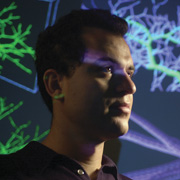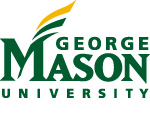Brain Domain
Mason neuroscientists are constructing a virtual brain that will revolutionize the field
By Lori Jennings and Colleen Kearney Rich, MFA ’95
How does the brain work? Where do character traits like creativity and humor originate? By studying nerve tissue and building a computational model, neuroscientist Giorgio Ascoli and his team of researchers at the Krasnow Institute for Advanced Study are trying to answer these fundamental questions.
For decades, the construction of a computational model of the brain has been a kind of holy grail in both neuroscience and computing. Through this research, Ascoli wants to gain a better understanding of how mind and body connect and interact. The findings have potential biomedical implications in the study and treatment of debilitating diseases such as epilepsy, Alzheimer’s, and Parkinson’s, as well as the mental decline that comes with aging.
 “We are looking at the mechanism underlying brain function,” Ascoli says. “How the nerves and their plasticity allow connectivity on a cellular level. By understanding the structure and the activity of the resulting network, we can attempt to infer answers to basic questions about how the brain works.
“We are looking at the mechanism underlying brain function,” Ascoli says. “How the nerves and their plasticity allow connectivity on a cellular level. By understanding the structure and the activity of the resulting network, we can attempt to infer answers to basic questions about how the brain works.
“When we recall an episode of our childhood, our thoughts, feelings, emotions, and imagination all correspond to or emerge from electrical waves in our brains,” he says. “How this is brought to be from a bunch of tree-shaped nerve cells is the beautiful mystery we are after.”
Last year, Ascoli and Alexei Samsonovich, a postdoctoral researcher at Krasnow, announced their joint discovery of a new form of nerve cell homeostasis, or state of equilibrium. They discovered that the anatomical structure of nerve cells is under homeostatic control, meaning that if one portion of a nerve cell is larger than average, another portion of the same cell will be smaller. This finding is unexpected in that the opposite is true in other natural systems (for example, people with larger hands also tend to have larger, not smaller, feet). Ascoli and Samsonovich proposed an explanation of their discovery based on cellular competition for limited resources.
“This finding helps us better understand how our brain is organized from a structural perspective—how our cells arrange themselves to optimize the limited resources available inside our skulls,” Ascoli says. “We are cautiously optimistic at this stage that these results will have a significant impact on the study of developing, damaged, or mutated nerve structures. This will eventually help us to better understand and even treat diseases.”
Ascoli and Samsonovich related their investigation to the widely accepted principle that physiological homeostasis, including the internal control of electrical activity, metabolism, and other neurological functions, is critical to the overall functioning of the brain. The researchers’ discovery demonstrates a new and fundamental form of homeostasis, namely the regulation of the very size of nerve cells.
The founding editor-in-chief of the journal Neuroinformatics, Ascoli joined Krasnow in 1997 and is the founder and head of the Computational Neuroanatomy Group, a multidisciplinary research team comprising psychologists, biologists, physicists, computer scientists, engineers, mathematicians, and physicians. Since joining the university, he has received approximately $3.5 million in grants for work focusing on the development and application of new computational techniques to investigate how the complex morphology of nerve cells enables their function. Support for his work comes from the National Science Foundation and the National Institutes of Health.
Ascoli is also working on understanding how the changes of neuronal anatomy similar to those occurring in Alzheimer’s patients may cause the impaired behavior of nerve cells at the basis of memory loss and dementia. His research may shed light on the basic mechanisms underlying the neuronal malfunction that typifies Alzheimer’s and related diseases.
Working with Ascoli on these projects is a cadre of graduate students, postdoctoral fellows, and affiliated research faculty with backgrounds that range from psychology and neuroscience to computer science and informatics. They are working to acquire microscopic images of nerve cells, generating a database of brain connectivity, and working on computational analyses.

Neuroscientist Georgio Ascoli with doctoral candidate Sridevi Polavaram.
The Digital Edge
Giorgio Ascoli joins a team of prominent researchers from Cornell University, Yale University, CalTech, Stanford, and the University of California, San Diego, in creating a digital framework for the study of neuroscience. The team has a $1.5 million contract awarded by the National Institute on Drug Abuse, part of the National Institutes of Health.
Ascoli serves as Mason’s principal investigator for his portion of the contract, which will involve the creation of a digital inventory of all three-dimensional reconstructions of nerve cells available in the neuroscience community.
The resulting database will eventually allow researchers to mine and extract valuable information on the nerve cells, essentially serving as a central resource of nerve cell data that may lead to valuable scientific insights on aging and disease states.
“This work will truly open up the field of neuroscience, similar to what the human genome project did for the field of biology,” says Ascoli. “Successful implementation of this work will provide the scientific community with one entry point to search, collect, and obtain data on nerve cell structure.”

